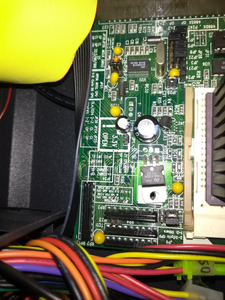First post, by squelch41
Hi,
I'm trying to get a AMD 5x86 133 to run at 160MHz
I can post and get to dos etc but once start stressing the CPU eg playing duke3d for more than a few seconds, it crashes.
My motherboard (model number in signature) supports 3.3v and 5v via a jumper.
I wanted to try and get a slight over-volt to stabalise the CPU - I was aiming for something like 3.8-4v.
I'm trying to work out how the voltage generation works.
There is an LM431 next to a couple of electrolyic capacitors, some resistors and then a TIP31C
(image attached)
Using a multimeter, it seems that the VREF pin of the LM431 attaches to the R15 resistor and then the other side of that resistor goes to ground
With the voltage jumper open (so 3.3v supply) this seems to connect R3 to the VREF pin and it's other side goes to 5v
If the jumper is closed (so 5v supply) it seems R5 is used instead of R3.
The output of the LM431 goes to the TIP31c
However, I don't understand how this works.
Measuring VREF with the jumper open gives 2.4v relative to ground and 2.6v with the jumper closed.
The data sheet for the LM431 says that the output voltage = Vref * (1+ (R1/R2))
R15 is marked 302 on the resistor but measures 1k when place probes on either side of the package
R5 is 122 but measures 870 ohms
R3 is 200 and does measure 20 ohms
What I was hoping I could do is to add additional resistance across the jumper to reduce the 5v supply (so essentially increasing R3s value), or if the resistance had to be decreased, piggy back a resistor in parralel.
However, I am obivously missing something or am just totally off on the wrong track!
I was hoping for some advice.
Picture of (what I think!) is the relevant part of the board attached.
Think this is the rough wiring of the LM431:
Shut jumper (5v):
GND--> R15 --VREF----R5-->5v
Open jumper (3.3v)
GND --> R15 ---VREF---R3--->5v
V4P895P3 VLB Motherboard AMD 486 133MHz
64mb RAM, CF 4Gb HDD,
Realtek 8019 ethernet + XT-IDE bios ROM, ES1869 soundcard, VLB Cirrus Logic GD5428 1mb VGA
440bx MSI 6119, modified slocket , Tualitin Celeron 1.2Ghz 256mb SD-RAM, CF 4GB HDD, FX5200 gfx
